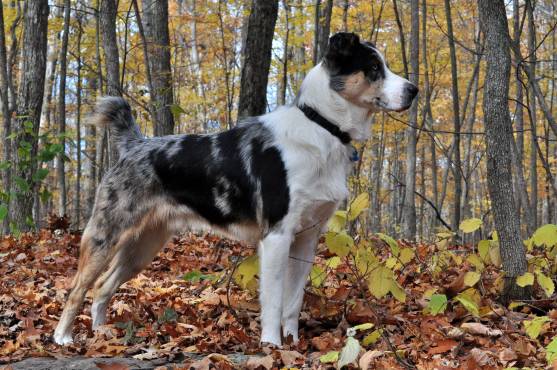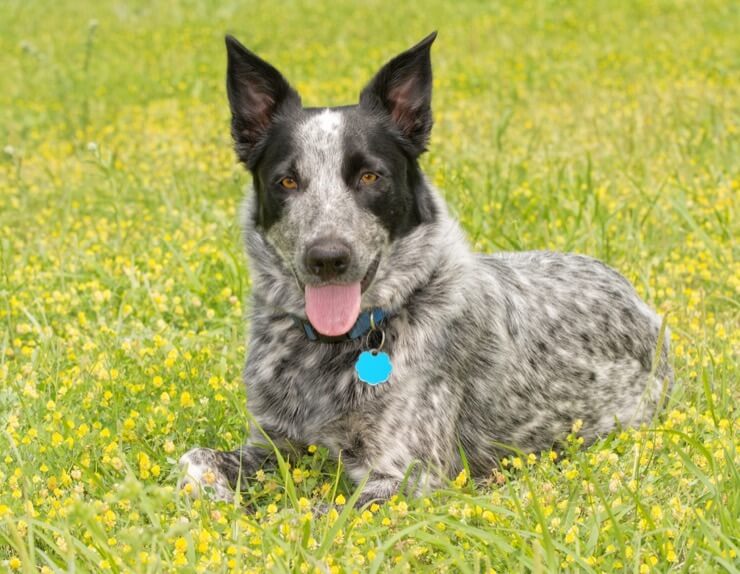Connect with a verified veterinarian in minutes. Licensed vets are available 24/7 to answer your questions. No need to worry about your furry family member.
Do you love Border Collies and Blue Heelers? Then you may be interested in adopting a Border Heeler! These dogs are a combination of two wonderful herding dogs! If you adopt one of these dogs, you’ll have tons of fun together!
Read on if you’d like to learn more about Border Heelers. We’ve included the information you need to make an informed decision on whether this is the right dog for your family! Let’s get started!
What is a Border Heeler?
A Border Heeler is a hybrid dog (sometimes also referred to as a designer dog) that comes from crossing a Border Collie with a Blue Heeler. No one is sure about the history of this hybrid dog; however, we can take a look at both parents to learn more about this adorable hybrid mix!
The Border Collie is an ancient dog breed that originally came from Britain. The dogs were bred to herd and guard sheep and were popular throughout Britain and Scotland. These dogs were considered one of the most valuable possessions of farmers and shepherds.
Border Collies are famous for the ability to herd sheep! If you’ve ever watched a herding competition, these dogs are very intense and committed to the job they’ve been given. It’s amazing to watch them in action! These dogs have the energy and stamina needed to herd sheep all day long, even over rough terrain.
The other parent of the Border Heeler is the Blue Heeler. Blue Heelers are dogs also bred to herd cattle! The dogs are highly intelligent, have a ton of energy, and have a strong work ethic. They’re very alert and protective, too.
Blue Heelers tend to be independent dogs; however, some of them may be attached to one special person. These dogs have plenty of durability and toughness, too.
Did you know Blue Heelers are a mix of Australian Dingoes and Collies? This makes them a very unique dog breed! Dingoes are wild dogs found in Australia, so Blue Heelers are sometimes called Australian Cattle Dogs.
Border Collies and Blue Heelers are not very snuggly dogs. They usually prefer having a job and doing it well! However, they are loyal and affectionate with their families.
With parents like this, it’s no wonder a Border Heeler is such a popular hybrid mix!
Border Heelers usually stand between 17 to 20 inches tall and weigh between 35 to 50 lbs. They have a life expectancy between 13 to 17 years.
Border Heeler Appearance
Border Heelers are hybrid dogs, and it’s almost impossible to predict the specific traits a dog will have. However, with a Border Heeler, both parents have strong, athletic bodies. They’re also usually a little taller than their Heeler parent.
Their coat is usually a short or medium double coat that comes in a wide range of colors and patterns. One of the most common colors is black, with speckled white on certain areas of the body. You may also see blue, merle, mottled red, red speckled, or tricolor dogs. Their coats may also contain some white, however, that’s not always the case.

Review symptoms, medications & behavior to keep your pets healthy with a Vet Online in just minutes.
Ask a Vet Live NowBorder Heeler Temperament
Border Heelers are both alert, highly intelligent, loyal dogs. Both breeds are also very durable, strong, and they love their job of herding cattle! Both breeds are also somewhat wary of strangers. When they don’t receive enough mental stimulation, both dog breeds can create their own activities to release their boredom! And we’re pretty sure you won’t like what these dogs may cook up!
As you may guess, the Border Heeler usually has the same traits as the breed’s purebred parents. These dogs can make loving, caring family companions. What’s more, they also get along well with kids and have the energy to keep up with them! The dogs usually get along with other animals, too.
In addition, you may want to train your fur baby to help you around the house. Remember, these are working dogs who want a job to do. A Border Heeler can be trained to help with a wide range of tasks. Your canine companion wants and needs a job to do and will become a happy camper if you teach him to help you around the house.
Are Border Heelers Good Family Dogs?
The answer is yes! They’re excellent family companions that get along well with other dogs and pets. These hybrid dogs are also good with kids and love having someone to play with them.
In addition, the dogs can be trained to help around the house. They want a job to do and take readily to training.
Training the Border Heeler
The Border Heeler is a very intelligent hybrid dog and is easy to train. They’re full of energy and benefit from proper training and socialization from a young age. These dogs respond best to positive reinforcement training methods. They also love having varied activities to keep their minds stimulated. Be sure to offer your fur baby plenty of praise and have a few treats on hand as encouragement!
Because these are herding dogs, it’s imperative to understand that they may sometimes try to herd family members. Border Heelers may try to herd kids, other pets, and even seniors! So, socialization and training are necessary for this reason, too.
Exercise Requirements
Border Heelers need plenty of exercise and mental stimulation. For this reason, they need about two hours of exercise every day. That’s a lot of exercise! If you’re not able to exercise a dog this much, then you may want to consider another dog breed that doesn’t require as much activity.
When the Border Heeler has enough energy, he may not try to herd your family or other pets! He’ll also stay out of mischief! But remember, these dogs also require plenty of mental stimulation. So, it’s a good idea to buy interactive dog toys and puzzles to keep your fur baby’s mind busy!
Grooming Requirements
Border Heelers shed moderately; however, this can be reduced by brushing their fur about once or twice a week. That way, you can control the amount of fur on furniture, clothing, and more!
The dogs only need a bath when necessary. Bathing them too frequently can strip natural oils from their skin and coat. This can lead to skin irritation and itchiness.
Diet & Feeding
Border Heelers are extremely active dogs, so they require high-quality dog food that is high in protein. The dog food should be specially formulated for medium-sized active dogs.
Border Heelers need between 2 and 2.5 cups of dog food twice a day. However, this amount should be determined by the age, size, and activity level of your dog.
Summing It Up
So, there you have it! Border Heelers make wonderful companions for active families and experienced pet parents. These are dogs that need a job to do, so it may be a good idea to train your canine companion to help with various tasks around the house!
We’re sure if you choose to adopt a Border Heeler, you’ll have a loving, energy-filled companion for years to come!
Connect with a verified veterinarian in minutes. Licensed vets are available 24/7 to answer your questions. No need to worry about your furry family member.

Tom
Tom has always loved to write since he was little - he wanted to be either a writer or a veterinary doctor, but he ended up being a professional writer while most of his works are based on animals. He was born in San Francisco but later moved to Texas to continue his job as a writer. He graduated from the University of San Francisco where he studied biotechnology. He is happily married and a soon to be father!
Review symptoms, medications & behavior to keep your pets healthy with a Vet Online in just minutes.
Ask a Vet Live Now




